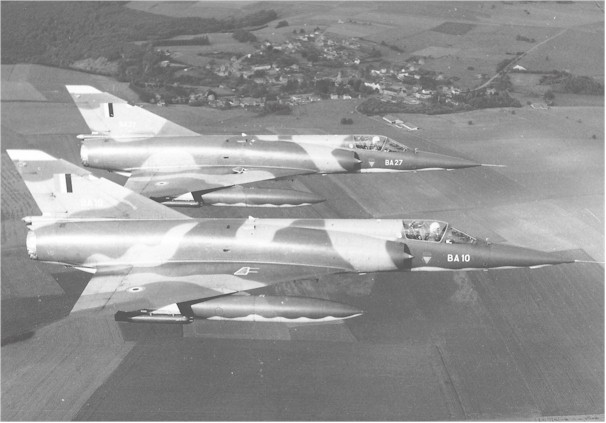 |
The day the first Belgian Mirage crashed.
 |
Here we encountered a first minor mishap. Indeed, Tienne called out that he was
hit by a bird. I joined up to search for eventual damage at his aircraft.
Luckily the bird or birds didn’t enter the air-intakes. His engine kept running
smoothly and there were no alarming indications displayed on his
cockpit-instruments. On the other hand I noticed that his "adhemar", a small
horizontal conical movable axis, placed on the left side of the nose to indicate
the angle of attack of the aircraft, was almost completely snatched off and was
of no further use. Furthermore, the bird had punched a hole, as big as a fist,
into the "châssis canon" of his Mirage, situated in the frontal belly of the aircraft.
The overall damage to the aircraft would cause no danger for a safe continuation
of the flight. Would it have been a real war-mission the probable obstruction of
the 30 mm canon would have handicapped Tienne a lot, as the only means of
self-defence would have been lost.
In the mean time we continued our mission as documented in the CMF. We were
supposed to reach the IP, the highway junction of Heilbronn, pretty soon. For a
unknown reason Toto passed a few kilometres south of the IP and continued on a
easterly heading. After a few minutes the skyline clearly indicated what I
expected. Indeed, in my CMF and on the terrain the huge American Army Aviation
airfield of Schwabisch Hall was just a few kilometres away, dead ahead. Without
hesitation I informed Toto over the radio that we should immediately make a
sharp turn of 180 degrees, in order to avoid the control-one of the airfield and
to reach our IP without delay. So we all did as suggested. The highway-crossing
of Heilbronn was this time easily identified and the German military, busy in
their daily work at their NIKE-site, were probably slightly surprised when we
roared over our equivalent target.
When we had again our act together after the simulated attack, we just faced one
important problem. We were supposed to have a comfortable amount of fuel to get
home. The reality of life was that we had flown already at low level for more
than 50 minutes and consequently we had consumed 700 litres over our planned
quantity. Indeed, with our internal fuel of 3000 litres and 3400 litres in the
two external fuel-tanks, we would normally easily land with the required minimum
fuel of 1200 litres, while flying the whole mission at low altitude.
The only initiative to restore some flying comfort inside the four cockpits was
to climb immediately at an altitude of 30.000 feet (10 kilometres) where the
fuel consumption of our insatiable Mirages was more economic. Toto therefore
slammed his throttle forward, pointed his nose upwards into the slightly cloudy
sky and a few minutes later we were travelling at a speed of Mach 0,8 (850
kilometres an hour), in a straight line towards Florennes.
A quick check revealed that none of us would land with the prescribed minimum
fuel. But hoping that the weather during the recovery would be acceptable, we
would again gain some time and some fuel if we could descent visually. When we
passed abeam the airway chokepoint of Nattenheim, it was about time to contact
Belga Radar, the military air traffic centre of Semmerzaeke that assists all
military aircraft that fly over the Belgian territory.
When we were after a while listening out on Belga we were ill at ease. Firstly
there was a lot of radio traffic. This was an indication that a lot of aircraft
were returning home at high altitude. Furthermore, we recognized a lot of voices
of our squadron colleagues. The assessment of the situation was that in order to
set up a safe traffic-stream into our home-base, we would certainly encounter
some delay with as a result less fuel in our tanks, who were really drying up.
Secondly, we had no radio-contact with Jean. It was clear that he received the
radio-calls but could not transmit any message. As he had also the lowest
fuel-reserve, we followed the standard procedure. He joined up into my right
wing and we both would descent first. Toto and Tienne would follow a few
kilometres behind us. As we informed Belga of our precarious fuel situation, we
obtained some priority for the descent. With hand-signs I informed Jean of our
intentions and configuration-changes. The descent went smoothly and we were
braking clouds well east of Dinant. With Jean in my wing in landing
configuration, I spotted the lights of runway 26 R (right) just after crossing
the river Meuse. In front of these lights I made it clear to Jean that the
runway was in front and he could land, by pointing my index forward. With some
800 litres left I decided to overshoot and to land out of a close circuit. At
that specific moment my attention was caught by a black apparently dense
air-mass that was blocking as a real wall the airspace situated pretty close to
the end of the runway. This situation didn’t cause any harm to me. I landed,
pulled my drag-chute and entered the taxitrack after a standard braking action.
I was of course curious to know where Tienne and Toto were at that moment. On
the radio I heard that the latter announced clearly that he would make a low
approach for both Mirages while Tienne, flying apparently on the fumes of his
fuel-tank, decided to land because he had a non-obstructed runway in front and
he felt comfortable enough to do so. Toto performed also a close circuit and
landed without hesitation. This apparent disobedience of Tienne was no reason
for any supplementary excitement afterwards, taking into consideration the
sequence of events during and after our mission.
In any case, we were all satisfied that we were all four safely on the ground,
and it is true, all with less than 600 litres on the fuel-counter. So we taxied
to our parking places. But it would take a hell of a time before we could shut
down our engines. Indeed first we had to take cover for an imminent air-attack,
announced by the control-tower. We decided to park our aircraft temporarily with
running engines in the vicinity of two maintenance hangars. The attackers, 6
aircraft of our squadron, suddenly popped up but disappeared abruptly in the
earlier observed dark low clouds, that had reached the boundary of the airfield.
From that moment on the paralyzing effect of a huge snow-shower immobilized all
activities of an airbase under TACEVAL. Everybody took cover. All aircraft,
ready to land, were ordered to land elsewhere. Afterwards we were informed that
we were the last complete formation who was lucky to land at Florennes after a
flight of 1 hour 30. In any way, within minutes Florennes airbase was
transformed into a white carpet which made any movement of aircraft a risky
undertaking. When finally it stopped snowing, we continued for the last portion
of our mission, trying to find back our parking-place in the white landscape.
Luckily, the lights along the taxitracks gave us some confidence and valuable
information where was the physical limit between the asphalt and the grass.
Furthermore, the surface was rather slippery but the mini-stops with their
pulsating braking kept us all on the hardened surfaces. This kind of ABS, that
we find these days on all our cars, was of great help because without nose-wheel
steering, particularly on slippery terrain, driving a Mirage by alternative
braking on the two main wheels was not always an easy job.
Before to park my BA 03 at the appropriate location, I encountered the last
surprise of the day. After crossing the civilian road Florennes-Corenne, just
behind the sharp descending turn of the taxitrack, another Mirage who missed
his parking, was approaching head on. We managed to cross in the snowed-up
environment of "les Aires Nord" just at the entrance of a parking lot with a few
centimetres of wingtip clearance.
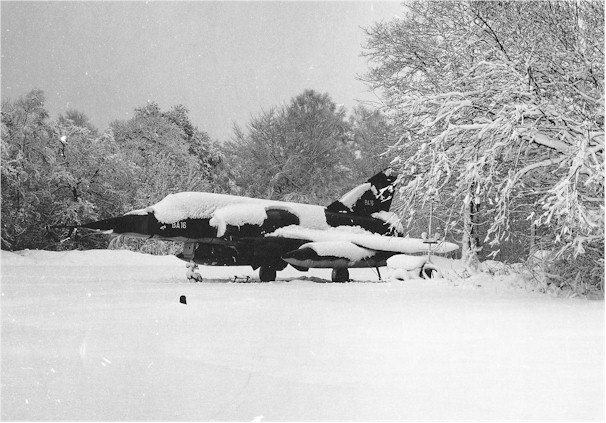 |
About 2 hours 30 after we left our parking bays, our impatient crew-chiefs were
happy to see us back. We were also very delighted that we finally could take
cover in our squadron-bunker. Here we noticed a certain tension and specially
when the OPS informed us after a while that for the time being all flying
activities were suspended, that most of the Belgian airfields were closed due to
havy snowfall and that we had no news about nine of our squadron-pilots. This
was alarming news and it gave us the feeling that missing nine of our best
friends during an exercise, that was simulating war conditions, could only be
fiction. But it lasted many many long minutes before this fear finally was
transformed into reassuring news. Indeed, one by one, the pilots who landed
elsewhere, very often in extremely difficult weather-conditions with almost no
fuel left, assured us that they were safe on the ground.
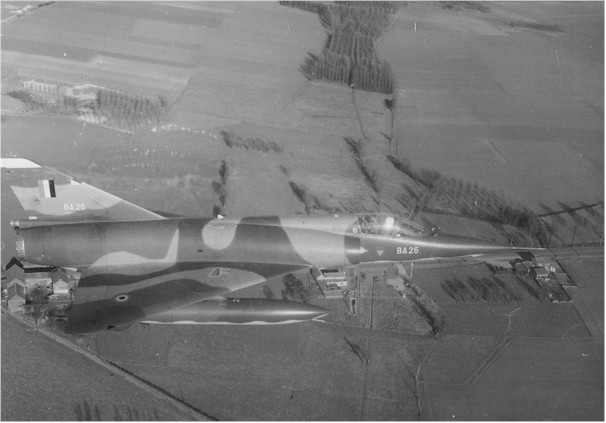 |
Unfortunately, for two of our friends who performed the simulated attack with
six aircraft and disappeared all in the snow-shower, the situation was more or
less dramatic. Duc as leader and Guy as his wingman, managed to stay together in
close formation. When they were in the final stage for a diversion landing at
the airfield of Bitburg, situated in Germany at some 100 kilometres south-east
of Florennes, Guy ran out of fuel and made use of his Martin Baker ejection seat.
The first Belgian Mirage with tail-number BA 25 would crash in the vicinity of
Bitburg in an open field. Guy phoned us after a while from the hospital that he
was in good condition and that he suffered only minor injuries at his back. Duc
reaches the airfield of Bitburg but a few hundred metres short of the runway
also his aircraft, the BA 28, flamed out and the landing without a running
engine ended in the grass. The aircraft was only slightly damaged and landed two
days later at his homebase.
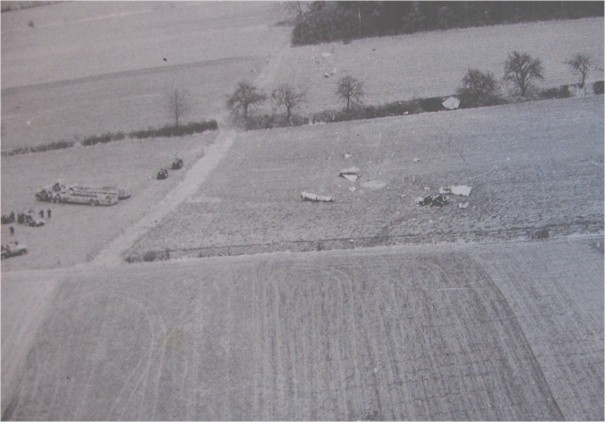 |
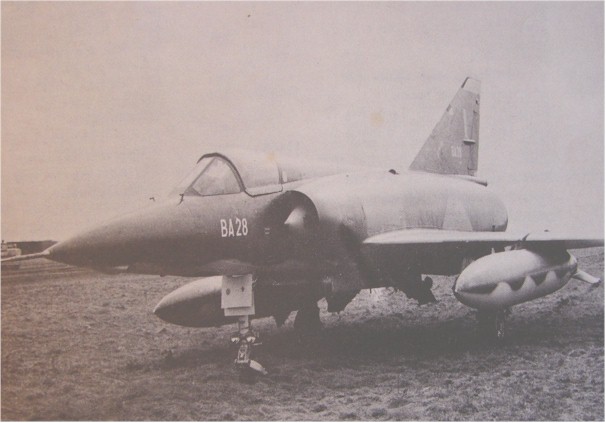 |
For us all the exercise-portion of TACEVAL was over. The following two days we
demonstrated to the TACEVAL-team by dropping exercise-bombs and by firing
rockets and our 30 mm canon at the firing range of Pampa, situated at Helchteren,
that the 2nd squadron was really operationally ready. Also the 42nd
squadron obtained their first standard operational qualification on their recce
version of the Mirage.
On 29 March 1972 all Belgian newspapers paid a lot of attention to the
snow-showers of the day before, with almost catastrophic consequences for the
Belgian Air Force who lost that day their first Mirage. The TACEVAL-team gave
the 2nd Wing of Florennes in her report the rating the unit and its
personnel really deserved. The investigation board of the Belgian Air Force,
examining the circumstances and causes of the aircraft crash, had not to so many
glorifying words to mention in their report. A lot of anomalies were identified,
particularly in the area of weather forecast, diversion capability and
procedures for aircraft
in distress and supervision of flying.
And to conclude, I have really no explanation why the flight of 28 March 1972
stays so lively in my memory. What unmistakable is correct is the observation
that all pilots, who flew that day, had a lot of luck.
De dag dat de eerste Belgische Mirage crashte.
Le jour
où le premier Mirage belge s'écrasa.